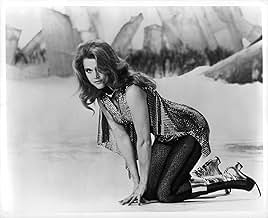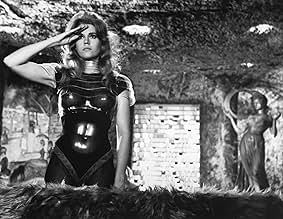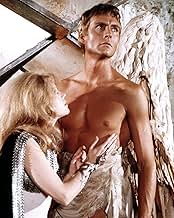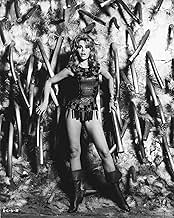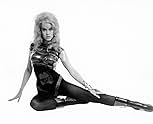NOTE IMDb
5,9/10
40 k
MA NOTE
Barbarella, un astronaute du 41ème siècle, cherche à arrêter le scientifique maléfique Durand Durand, dont le rayon positronique menace de ramener le mal dans la galaxie.Barbarella, un astronaute du 41ème siècle, cherche à arrêter le scientifique maléfique Durand Durand, dont le rayon positronique menace de ramener le mal dans la galaxie.Barbarella, un astronaute du 41ème siècle, cherche à arrêter le scientifique maléfique Durand Durand, dont le rayon positronique menace de ramener le mal dans la galaxie.
- Réalisation
- Scénario
- Casting principal
- Récompenses
- 1 nomination au total
Véronique Vendell
- Captain Moon
- (as Veronique Vendell)
Franco Gulà
- The Suicide
- (scènes coupées)
- (as Franco Gula)
Honey Autumn
- Bald Handmaiden at Sogovian Court
- (non crédité)
Silvana Bacci
- Girl in Sogo
- (non crédité)
Avis à la une
If you're looking for a cult classic, they don't come much stranger than sexed-up and super-silly BARBARELLA, the peculiar tale of an intergalactic secret agent (Jane Fonda) sent to a rebel planet to find a mad scientist named Duran Duran (Milo O'Shea.) Directed by Fonda's then-husband Roger Vadim, the film is less concerned with creating a coherent storyline than it is in finding inventive ways to strip Fonda of her already skimpy outfits.
In this it is remarkably successful, and Fonda actually has both enough sex appeal and round-eyed innocence to carry the thing off, emerging as something like a Barbie doll; John Philip Law strikes a similar note as the sexy but equally innocent "angel" Pygar. The designs are 1960s psychedelic with as many Freudian twists as the film's makers can come up with, and when all is said and done you can't help but roll your eyes in amusement.
True enough, BARBARELLA was probably much more entertaining back in the days LSD, and indeed one might read the entire thing as an acid trip time machine. No one in the cast takes the film very seriously, and neither should you; when all is said and done it has all the depth of a pancake, not so much funny as merely amusing and appealing to a very high-camp sensibility. But as cult movies go, it ranks right up at the top. Give a party and show it on a double bill with FLESH GORDON! Gary F. Taylor, aka GFT, Amazon Reviewer
In this it is remarkably successful, and Fonda actually has both enough sex appeal and round-eyed innocence to carry the thing off, emerging as something like a Barbie doll; John Philip Law strikes a similar note as the sexy but equally innocent "angel" Pygar. The designs are 1960s psychedelic with as many Freudian twists as the film's makers can come up with, and when all is said and done you can't help but roll your eyes in amusement.
True enough, BARBARELLA was probably much more entertaining back in the days LSD, and indeed one might read the entire thing as an acid trip time machine. No one in the cast takes the film very seriously, and neither should you; when all is said and done it has all the depth of a pancake, not so much funny as merely amusing and appealing to a very high-camp sensibility. But as cult movies go, it ranks right up at the top. Give a party and show it on a double bill with FLESH GORDON! Gary F. Taylor, aka GFT, Amazon Reviewer
I first saw 'Barbarella' on TV as a small child in the 1970s and along with 'The Omega Man', 'One Million Years B.C.', and 'Jason and the Argonauts' the movie blew my tiny little mind! I think my interest in cult and bizarre began from seeing this classic slice of 1960s psychedelic trash for the first time. This is one of the silliest movies ever made, but still one of the most entertaining. Jane Fonda, then at the peak of her sex kitten period (history lesson - this was before "radical Jane" and "corporate Jane"), has never looked lovelier than in this movie, and manages to really pull off Barbarella's wide-eyed innocence. Anita Pallenberg (co-star of 'Performance' and then Keith Richards' "old lady") is stunning as The Great Tyrant, even if her voice is dubbed, and her handful of scenes with Fonda are unforgettable. The rest of the eclectic supporting cast includes cult favourites John Phillip Law ('Diabolik') as Pygar, the blind angel, David Hemmings ('Profondo Rosso') as Dildano a revolutionary, and Milo O'Shea ('Theatre Of Blood') as renegade Earth scientist Duran Duran. 'Barbarella' contains some of the most striking and surreal images of the 1960s (the doll attack scene is one of my all time favourites!), and is definitely one of the most bizarre science fiction movies ever made. Like many of the 1960s more excessive movies it is a real love it or hate it proposition. I love it of course, and think it, Russ Meyer's 'Faster Pussycat! Kill! Kill!', and Roger Corman's 'The Trip' are the three greatest 1960s trash classics. This is simply absolutely essential viewing for all 1960s buffs, science fiction or otherwise. Long live 'Barbarella'!
Barbarella (1968)
** (out of 4)
Campy sci-fi based on the French comics has Jane Fonda playing the title role, a futuristic superhero who is asked by the President of Earth to travel to a distant planet and rescue a doctor. I can understand why this film has gained a cult following over the past few decades but to me this thing is still a pretty big mess and it's somewhat shocking watching the film to day and looking back and wondering what the original producers were thinking. I mean, if you look at the "story" of this thing, it's a complete mess and it's all over the place. I'm not exactly sure what they were trying to do in regards to the story but it's a complete misfire. Not for a single second do you care about Barbarella's adventure nor do you care about anything she's doing in the film. The reason the film remains entertaining is because it's simply so strange and surreal. Visually the film is quite impressive as a bunch of pulp. The set design and costumes are certainly memorable and the now laughable special effects have a mild charm to them. What really keeps the film moving is seeing someone like Fonda doing a role like this. She's very good in the role, there's no doubt about it, as she can handle the campy moments as well as deliver on the sexuality of the character. Her nude striptease that starts the film is certainly the highlight but they needed more of these throughout. John Phillip Law isn't all that "good" in the film but there's no question that his angel character is quite memorable. Director Roger Vadim doesn't bring enough life, energy or fire to any of the scenes to really make them work and that's certainly not good when you're dealing with a film like this one. BARBARELLA certainly deserves its label as a camp classic but it's just not entertaining enough to be fully rewarding.
** (out of 4)
Campy sci-fi based on the French comics has Jane Fonda playing the title role, a futuristic superhero who is asked by the President of Earth to travel to a distant planet and rescue a doctor. I can understand why this film has gained a cult following over the past few decades but to me this thing is still a pretty big mess and it's somewhat shocking watching the film to day and looking back and wondering what the original producers were thinking. I mean, if you look at the "story" of this thing, it's a complete mess and it's all over the place. I'm not exactly sure what they were trying to do in regards to the story but it's a complete misfire. Not for a single second do you care about Barbarella's adventure nor do you care about anything she's doing in the film. The reason the film remains entertaining is because it's simply so strange and surreal. Visually the film is quite impressive as a bunch of pulp. The set design and costumes are certainly memorable and the now laughable special effects have a mild charm to them. What really keeps the film moving is seeing someone like Fonda doing a role like this. She's very good in the role, there's no doubt about it, as she can handle the campy moments as well as deliver on the sexuality of the character. Her nude striptease that starts the film is certainly the highlight but they needed more of these throughout. John Phillip Law isn't all that "good" in the film but there's no question that his angel character is quite memorable. Director Roger Vadim doesn't bring enough life, energy or fire to any of the scenes to really make them work and that's certainly not good when you're dealing with a film like this one. BARBARELLA certainly deserves its label as a camp classic but it's just not entertaining enough to be fully rewarding.
Just what were they on? "Barbarella" is one of those sixties films (the Beatles vehicle "Help!" is another) which, although it makes no explicit references to the decade's drug culture, nevertheless leaves the indelible impression that the director, the scriptwriter, the set designer, the costume designer, the cameramen and most of the cast were under the influence of mind-expanding drugs throughout the entire shooting period.
I first saw the film at university in the early eighties when a student film society organised a screening. Interest in it at that time may have been aroused by the release in 1980 of "Flash Gordon", another ultra-camp science fiction film which was undoubtedly influenced by it, and by the fact that one of the leading British pop groups of the era had called themselves Duran Duran in homage to their origins in a now-defunct Birmingham nightclub called Barbarella's.
The film is based on a French series of comic books, which I must admit I have never read. (Unlike, say, the "Asterix" or "Tintin" series, the Barbarella comics have never had much of a following in Britain). The action takes place in the 40th century. Barbarella, a beautiful young female astronaut, is ordered by the President of Earth to travel to the planet Tau Ceti to find a scientist named Durand Durand, from whom the band took their misspelled name. Durand is the inventor of a weapon known as the Positronic Ray, which the President fears may fall into the wrong hands.
The rest of the film is taken up with Barbarella's increasingly bizarre adventures on Tau Ceti. She goes ice-skiing across the planet's frozen surface, pulled along by an octopus-like creature, is menaced by flesh-eating dolls with razor-sharp teeth, seduces a blind angel (or "ornithanthrope"), meets the predatory lesbian Queen of a decadent city and survives an attempted execution by means of an "orgasmatron", a machine designed to kill by an excess of sexual pleasure. (Barbarella's capacity for sexual pleasure is so great that she blows its circuits). We are not, of course, meant to take any of this seriously; the whole thing is intended as a sort of tongue-in-cheek exercise in high camp surrealism, Salvador Dali meets Edna Everage. The surreal nature of the film is emphasised by the use of psychedelic lighting effects. (The opening song even includes the rhyme "Barbarella Psychedella").
Barbarella is played by Jane Fonda, who at the time was married to the director Roger Vadim, clearly a man with the knack of attracting beautiful women. (He had previously been married to Brigitte Bardot and had been the lover of Catherine Deneuve). I wonder if, when Fonda was taking her wedding vows, she realised that Vadim's interpretation of "for better or for worse" included casting his wife in eccentric films like this one. Her devotion to her wifely duties seems to have been at the expense of her career; she later revealed that her commitment to "Barbarella" meant having to turn down the leading roles in two more serious films, "Bonnie and Clyde" and "Rosemary's Baby". Moreover, many of the heroine's adventures seem to have been designed with the express purpose of showing off Fonda's figure in a series of provocative outfits, leaving her with a lasting "sex kitten" image. This was something she was never comfortable with, especially when she was trying to reinvent herself as a feminist and left-wing activist a few years later.
This is far from being Fonda's best film, yet she is about the only cast member who emerges with any credit from it, playing the heroine as a sort of wide-eyed innocent abroad. John Phillip Law, who plays the ornithanthrope Pygar, is so wooden that I wondered if he was under instructions to play his role with a deliberately deadpan lack of emotion. David Hemmings as the resistance leader Dildano shows us just why his career never really took off in the way it was expected to after his early breakthrough in "Blowup". (Hemmings's costume, looking like a pair of leather Y-fronts, is just as bizarre as anything worn by Fonda). Marcel Marceau shows that his talents as a mime did not extend to acting in spoken roles. Anita Pallenberg, better known for her relationships with several members of the Rolling Stones, was cast as the wicked Queen, but Vadim did not trust her to speak her own lines; the Queen speaks with the unmistakable contralto tones of Joan Greenwood.
"Barbarella" was a failure on its release, both at the box office and with the critics, yet despite the dodgy acting and the nonsensical plot it has since 1968 acquired the status of a cult movie. (Even back in my student days it was regarded as sort of historic artifact). Cults, whether religious or cinematic, can be baffling to everyone except ardent devotees, yet I must confess that I have a soft spot for this surreal relic of the hippie era. It is an ideal film to watch when returning from the pub late at night. Particularly if one is drunk. 6/10
I first saw the film at university in the early eighties when a student film society organised a screening. Interest in it at that time may have been aroused by the release in 1980 of "Flash Gordon", another ultra-camp science fiction film which was undoubtedly influenced by it, and by the fact that one of the leading British pop groups of the era had called themselves Duran Duran in homage to their origins in a now-defunct Birmingham nightclub called Barbarella's.
The film is based on a French series of comic books, which I must admit I have never read. (Unlike, say, the "Asterix" or "Tintin" series, the Barbarella comics have never had much of a following in Britain). The action takes place in the 40th century. Barbarella, a beautiful young female astronaut, is ordered by the President of Earth to travel to the planet Tau Ceti to find a scientist named Durand Durand, from whom the band took their misspelled name. Durand is the inventor of a weapon known as the Positronic Ray, which the President fears may fall into the wrong hands.
The rest of the film is taken up with Barbarella's increasingly bizarre adventures on Tau Ceti. She goes ice-skiing across the planet's frozen surface, pulled along by an octopus-like creature, is menaced by flesh-eating dolls with razor-sharp teeth, seduces a blind angel (or "ornithanthrope"), meets the predatory lesbian Queen of a decadent city and survives an attempted execution by means of an "orgasmatron", a machine designed to kill by an excess of sexual pleasure. (Barbarella's capacity for sexual pleasure is so great that she blows its circuits). We are not, of course, meant to take any of this seriously; the whole thing is intended as a sort of tongue-in-cheek exercise in high camp surrealism, Salvador Dali meets Edna Everage. The surreal nature of the film is emphasised by the use of psychedelic lighting effects. (The opening song even includes the rhyme "Barbarella Psychedella").
Barbarella is played by Jane Fonda, who at the time was married to the director Roger Vadim, clearly a man with the knack of attracting beautiful women. (He had previously been married to Brigitte Bardot and had been the lover of Catherine Deneuve). I wonder if, when Fonda was taking her wedding vows, she realised that Vadim's interpretation of "for better or for worse" included casting his wife in eccentric films like this one. Her devotion to her wifely duties seems to have been at the expense of her career; she later revealed that her commitment to "Barbarella" meant having to turn down the leading roles in two more serious films, "Bonnie and Clyde" and "Rosemary's Baby". Moreover, many of the heroine's adventures seem to have been designed with the express purpose of showing off Fonda's figure in a series of provocative outfits, leaving her with a lasting "sex kitten" image. This was something she was never comfortable with, especially when she was trying to reinvent herself as a feminist and left-wing activist a few years later.
This is far from being Fonda's best film, yet she is about the only cast member who emerges with any credit from it, playing the heroine as a sort of wide-eyed innocent abroad. John Phillip Law, who plays the ornithanthrope Pygar, is so wooden that I wondered if he was under instructions to play his role with a deliberately deadpan lack of emotion. David Hemmings as the resistance leader Dildano shows us just why his career never really took off in the way it was expected to after his early breakthrough in "Blowup". (Hemmings's costume, looking like a pair of leather Y-fronts, is just as bizarre as anything worn by Fonda). Marcel Marceau shows that his talents as a mime did not extend to acting in spoken roles. Anita Pallenberg, better known for her relationships with several members of the Rolling Stones, was cast as the wicked Queen, but Vadim did not trust her to speak her own lines; the Queen speaks with the unmistakable contralto tones of Joan Greenwood.
"Barbarella" was a failure on its release, both at the box office and with the critics, yet despite the dodgy acting and the nonsensical plot it has since 1968 acquired the status of a cult movie. (Even back in my student days it was regarded as sort of historic artifact). Cults, whether religious or cinematic, can be baffling to everyone except ardent devotees, yet I must confess that I have a soft spot for this surreal relic of the hippie era. It is an ideal film to watch when returning from the pub late at night. Particularly if one is drunk. 6/10
Really and truly, this could be the plot of one of the more "high-brow" types of porn. I watched this with a bunch of other girls for a class, and we could not stop laughing the entire time.
See Jane Fonda meet men from around the galaxy, and have sex with them! Dare your friends to count how many times she changes her costume!! Sparks deep philosophical discussion, like what exactly the writers were on when they wrote this. Great fun, not to be missed!
See Jane Fonda meet men from around the galaxy, and have sex with them! Dare your friends to count how many times she changes her costume!! Sparks deep philosophical discussion, like what exactly the writers were on when they wrote this. Great fun, not to be missed!
Le saviez-vous
- AnecdotesThe scenes during the opening credits where Barbarella seems to float around her spaceship were filmed by having Jane Fonda lie on a huge piece of Plexiglas with a picture of the spaceship underneath her. It was filmed from above, creating the illusion that she is in zero gravity.
- GaffesIt is established that Barbarella needs a Tongue Box, a device attached to the bracelet she wears on her left wrist, to understand the spoken language of Sogo. Barbarella loses the bracelet after the Excessive Machine scene, but she still understands the Great Tyrant, Pygar, and the Sogoites speaking through the Tyrant's monitor.
- Citations
Barbarella: What's that screaming? A good many dramatic situations begin with screaming...
- Crédits fousIn the opening credits, the letters in the words move around in an attempt to obscure Barbarella's nudity.
- Versions alternativesBarbarella was released in the USA before the MPAA introduced the motion picture rating system on November 1, 1968. It was consequently released with a tag "Suggested For Mature Audiences". A re-release in 1977 (to cash in on the success of Star Wars: Épisode IV - Un nouvel espoir (1977)) was edited to obtain a "PG" rating and was called "Barbarella: Queen Of The Galaxy". The video version is of the original uncut version and not the "PG" version (despite the subtitle "Queen of the Galaxy" and the "PG" rating on the cover).
- ConnexionsEdited into Duran Duran: Burning the Ground (1989)
Meilleurs choix
Connectez-vous pour évaluer et suivre la liste de favoris afin de recevoir des recommandations personnalisées
- How long is Barbarella?Alimenté par Alexa
- Was Barbarella a virgin before meeting the Fur Trapper?
Détails
- Date de sortie
- Pays d’origine
- Langues
- Aussi connu sous le nom de
- Barbarella: Queen of the Galaxy
- Lieux de tournage
- Sociétés de production
- Voir plus de crédits d'entreprise sur IMDbPro
Box-office
- Budget
- 9 000 000 $US (estimé)
- Montant brut mondial
- 1 622 $US
- Durée1 heure 38 minutes
- Couleur
- Rapport de forme
- 2.35 : 1
Contribuer à cette page
Suggérer une modification ou ajouter du contenu manquant




